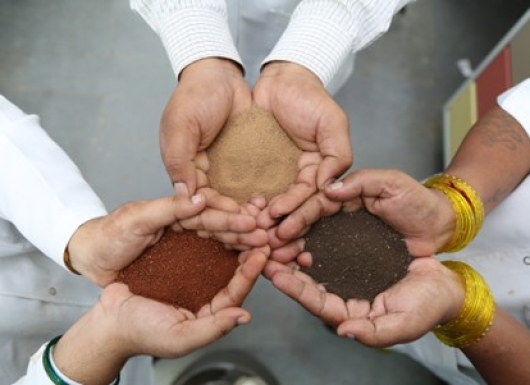Submitter: (ICRISAT)
Most soil health assessments rely heavily on chemical analysis, often overlooking the critical physical and biological dimensions that influence how soils function under real-world field conditions. This approach introduces a scientifically grounded and field-deployable framework that integrates novel soil health indicators across physical, nutrient, and biological properties to more effectively assess, manage, and restore soil performance.

A comprehensive soil health framework involves integrating physical, chemical, and biological indicators. While physical attributes influence root development and water retention, chemical properties govern nutrient availability, and biological indicators reflect microbial activity and nutrient cycling. ICRISAT’s soil laboratories and expertise support integrated soil health assessment protocols, which can be standardized and implemented across large landscapes. Soil health management is fundamental to achieving sustainable agricultural productivity and long-term ecosystem resilience.
Novel Indicators: Incorporates overlooked but essential measures alongside standard nutrients. Soil Function, Not Just Fertility: It evaluates how soil performs essential functions like water retention, nutrient cycling, and root support, enabling a functional assessment rather than just a chemical snapshot.
Supports Decision-Making: By capturing multiple soil constraints, the method directly informs practical decisions on land treatment, crop selection, and input use, improving efficiency and productivity.
Outputs an SDI (Soil Degradation Index): It generates a single, interpretable index that integrates physical, chemical, and biological data, and has shown strong correlation with crop yield, soil degradation risk, and system resilience.
This integrated approach has been successfully piloted in research farms, land restoration sites, and smallholder agroecosystems, where declining yields and soil degradation are linked to overlooked physical and biological constraints. It is currently being implemented in multi-village pilot programs to detect hidden soil issues that are not captured by conventional soil testing. The approach holds strong potential for application in degraded farming systems, where comprehensive soil insights are critical for sustainable productivity and land management.
Over 3,000 soil samples were assessed from smallholder farms across diverse districts in Uttar Pradesh and Maharashtra, representing a broad spectrum of soil conditions and farming practices. Through this large-scale assessment, a Soil Degradation Index (SDI) was developed by combining physical, nutrient, and biological indicators into a unified metric. The SDI exhibited a strong correlation with crop yield, making it a reliable predictor of productivity. Unlike conventional assessments focused solely on NPK values, the SDI successfully identified hidden degradation issues, such as compaction or low microbial activity, that contributed to unexplained yield gaps. This confirms the SDI’s utility as a diagnostic tool for identifying degradation that is often missed in conventional NPK-based assessments, and as a guide for more effective, system-responsive land and nutrient management in smallholder contexts.
The integrated soil health assessment approach is low-cost, adaptable, and partner-ready, making it well-suited for widespread adoption across diverse farming systems.